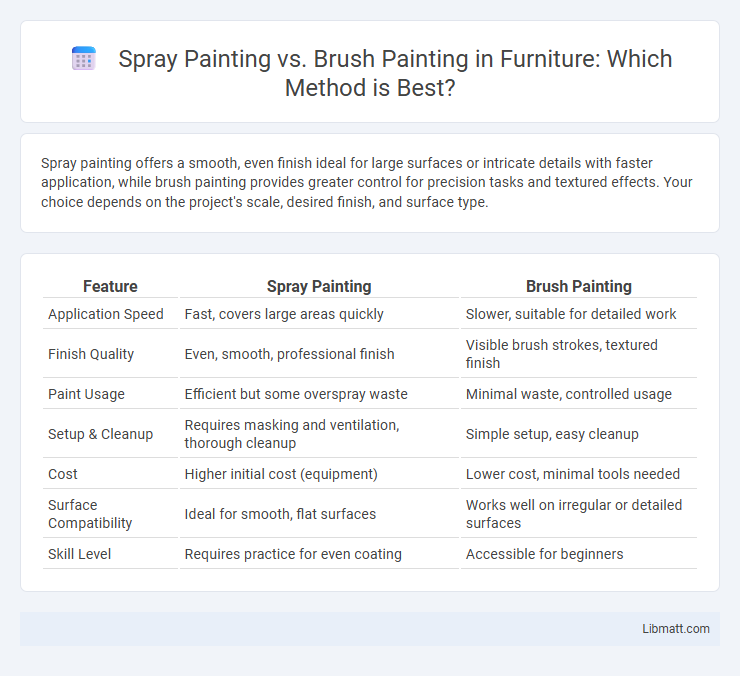Spray painting offers a smooth, even finish ideal for large surfaces or intricate details with faster application, while brush painting provides greater control for precision tasks and textured effects. Your choice depends on the project's scale, desired finish, and surface type.
Table of Comparison
| Feature | Spray Painting | Brush Painting |
|---|---|---|
| Application Speed | Fast, covers large areas quickly | Slower, suitable for detailed work |
| Finish Quality | Even, smooth, professional finish | Visible brush strokes, textured finish |
| Paint Usage | Efficient but some overspray waste | Minimal waste, controlled usage |
| Setup & Cleanup | Requires masking and ventilation, thorough cleanup | Simple setup, easy cleanup |
| Cost | Higher initial cost (equipment) | Lower cost, minimal tools needed |
| Surface Compatibility | Ideal for smooth, flat surfaces | Works well on irregular or detailed surfaces |
| Skill Level | Requires practice for even coating | Accessible for beginners |
Introduction to Spray Painting vs Brush Painting
Spray painting offers a fast, even coat ideal for large surfaces and intricate details, using compressed air or electric sprayers to atomize paint into fine particles. Brush painting provides precise control and texture, making it suitable for smaller areas, trim work, and projects requiring detailed craftsmanship. Each method varies in application technique, finish quality, and drying time, influencing project choice based on surface type and desired results.
Key Differences Between Spray Painting and Brush Painting
Spray painting offers faster and more even coverage, ideal for large surfaces and intricate details, while brush painting allows for better control and precision on smaller areas or textured surfaces. Spray paint creates a smoother, more uniform finish with less visible brush strokes, whereas brush painting may leave texture and requires more drying time between coats. The choice depends on project size, surface type, and desired finish quality, with spray painting suited for speed and consistency, and brush painting preferred for fine detail and touch-ups.
Surface Preparation: What’s Needed for Each Method
Surface preparation for spray painting requires thorough cleaning and masking to prevent overspray on unintended areas, ensuring a smooth, dust-free surface for even application. Brush painting demands sanding to create a key for paint adhesion, along with filling imperfections to avoid visible strokes and uneven texture. Your choice influences the level of prep work; spray painting prioritizes precision masking, while brush painting relies on detailed surface smoothing.
Ease of Application: Spray vs Brush Techniques
Spray painting offers a faster and more uniform application, making it ideal for covering large surfaces or intricate details without brush marks. Brush painting provides greater control and precision, allowing you to easily reach corners and create textured finishes. Choosing between spray and brush techniques depends on your project size, detail requirements, and desired surface smoothness.
Finish Quality and Appearance Comparison
Spray painting delivers a smoother, more uniform finish with fewer visible brush strokes, making it ideal for large, flat surfaces and intricate details where a flawless appearance is essential. Brush painting can result in textured surfaces and visible strokes that add character but may require multiple coats for even coverage. Spray painting often achieves quicker drying times and a more professional, high-gloss look compared to the subtle, handcrafted aesthetic of brush-applied paint.
Time Efficiency: Which Method Is Faster?
Spray painting offers significantly faster coverage compared to brush painting, enabling you to complete large surfaces in a fraction of the time. Spray guns distribute paint evenly and smoothly, minimizing drying intervals and reducing overall project duration. Your choice between these methods depends on the scale and precision required, with spray painting excelling in time efficiency for expansive areas.
Cost Analysis: Materials and Labor
Spray painting typically incurs higher initial costs due to the need for specialized equipment like compressors and spray guns, while brush painting requires minimal investment in brushes and rollers. Labor costs for spray painting can be lower because it covers large surfaces quickly and evenly, reducing man-hours compared to the slower, more detailed brush application. Material consumption varies, as spray painting often results in more overspray waste, whereas brush painting ensures more controlled and efficient use of paint.
Best Use Cases for Spray Painting
Spray painting is ideal for covering large surfaces quickly and evenly, making it the preferred method for painting vehicles, fences, and furniture with smooth finishes. It excels in reaching intricate details and textured surfaces where brushes may leave streaks or miss tight spots. The technique also reduces drying time and creates a uniform coat that enhances durability and aesthetic appeal on outdoor and industrial applications.
Ideal Projects for Brush Painting
Brush painting is ideal for detailed and small-scale projects, such as furniture, trim, and cabinetry, where precision and control are essential. Your ability to maneuver the brush allows for intricate designs and touch-ups that spray painting cannot easily achieve. It also works well on surfaces with tight corners and edges, providing a smooth, even finish without overspray.
Choosing the Right Painting Method for Your Project
Spray painting offers a smooth, even finish ideal for large or intricate surfaces, while brush painting provides greater control and detail for smaller or textured areas. Your project's size, surface type, and desired finish quality determine the optimal method, with spray painting excelling in speed and uniform coverage. Selecting the right technique improves efficiency and enhances the durability and appearance of your paint job.
spray painting vs brush painting Infographic

 libmatt.com
libmatt.com